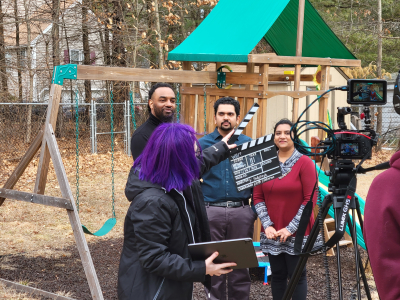

By Deepti Dutt | Mon, March 27, 23
My husband and I are proud New England home owners. This means that our house, like many in the area, is old and leaks like a sieve. Every summer, for the last four years, we painstakingly lugged our window a/c units from our basement to our second floor bedrooms and back to basement at the end of the summer. In both these trips, we make promises to ourselves and each other to look into whole home air conditioning solutions. We always tell ourselves that we need to do this research before an emergency happens.
Then this year, we got a sign from above that pushed us along – our relatives in the next town over had an emergency leak in their hot water heater. Their only choice was to make a quick and easy one-for-one replacement to get everything back online. That was the final straw for us; it pushed us start the project of whole home electrification.
Whole Home Electrification: A Multi-Step Process
We decided to start with MassSave. There are several steps to electrification. First a home auditor visited our home to do a walk through and gave a heavily subsidized (material is typically 75-100 percent off with additional labor) estimate on insulation and air sealing work. This was a reasonable quote because of the subsidies and so we continued on to the next step. The weatherization step included insulation in the attic, air sealing in the basement, insulation of the basement door, and a final blower door test to check the level of sealing. Since it’s an old house, we had to understand the practical limits of sealing when compared to a new construction.
After the weatherization step, HVAC experts from a MassSave-approved private contractor came over to discuss our space conditioning options. Since we don’t have any ducting, ductless mini-split air source heat pumps were the natural option. Then, we discussed water heating options to replace delivered fuel for space and water heating. We chose a tankless heat pump water heater (HPWH). Once we reviewed options and had our quotes, it was time to seek financing from a MassSave-approved bank. The financing options were fairly attractive with zero percent interest (in 2023!) over 84 months. Once the financing was secured, we were able to schedule an actual installation date with the contractor.
An Added Bonus
In my role as Technology Market Transformation Manager at NEEP, I work very closely with the Northeast HPWH Alliance. That project needed a home installation video recording in order to educate installers. I decided to volunteer my home installation for this purpose. D & R International conducted the video production and interviews. A multi-media informative webpage will be up soon that will include 360° visuals, podcasts, interviews of installers & homeowners (that’s us), and pictures of the installation space as well as equipment with detailed labeling.
The Decision
So, why did we choose a HPWH? Is now a good time for whole home electrification? The process is too time consuming and this is an old home so is it even worth it? What about my electric bills? What about the noise? It gets too cold here, what if the system fails? There’s a lot for homeowners to consider.
So, here’s what I think: when we first moved to this house, I wasn’t very thrilled about using oil for heating and hot water, especially because it’s a lot of maintenance and a possible fire hazard. Electrification was always something we wanted to do as its safer and there are no emissions at the household level. Also, it’s a good first step if we eventually plan to go solar. Right now, with so many rebates and incentives at state and federal level, it’s a good time to go electric.
All good things need patience. The process may be time consuming but it’s worth the effort. The weatherization and energy audit helped us understand how our home works. A drafty home can be very uncomfortable and have high energy costs. Then, as oil prices went up, we realized how burdensome space and eater heating can be, so weatherization in general helps bring down energy costs.
HPWHs are infamous for the noise, but here’s a fun fact: its components are very similar to those of a refrigerator, and we are all very used to the noise a refrigerator condenser makes in our kitchen. So used to it, honestly, that we barely notice it. HPWHs work in a reverse refrigeration cycle, that is the refrigerant takes warmth from its surroundings and heats up the water. The condensate that forms is completely harmless distilled water, which can be drained out via a laundry drain in the basement. Since its located in the basement, where the temperatures are never going to be below 35°F, the chances of a HPWH failing or freezing are slim. When its set on hybrid mode, if the demand for hot water is more than usual, it just switches to electric resistance mode to cater to the needs for the moment. HPWHs can be grid interactive so water heating is done at off-peak times. It is understandable to feel uncertain about new technologies, but HPWHs have been around for a while now, almost a decade, and have improved a lot.
Conclusion
As the price of fossil fuels tend to get erratic, switching to electric is inevitable. It’s safer and smarter to do this transition while existing equipment is functional and there is ample time to make informed decisions and to take advantage of all available incentives. There is help available to learn more about clean heat technologies, like the HeatSmart Alliance, where community volunteers coach homeowners interested in home electrification. The MassSave website and contractors listed on the website are experts in the field and can guide you through the process. We are still in the process of getting MassSave rebates which are significant ($10,000 for whole home system) and are sweating a bit about the jump in monthly electricity bill (which will eventually be offset by the oil refill costs). I hope to write another blog in about a year to update you on my amazing (fingers crossed) first year with our new technologies. Stay tuned!


